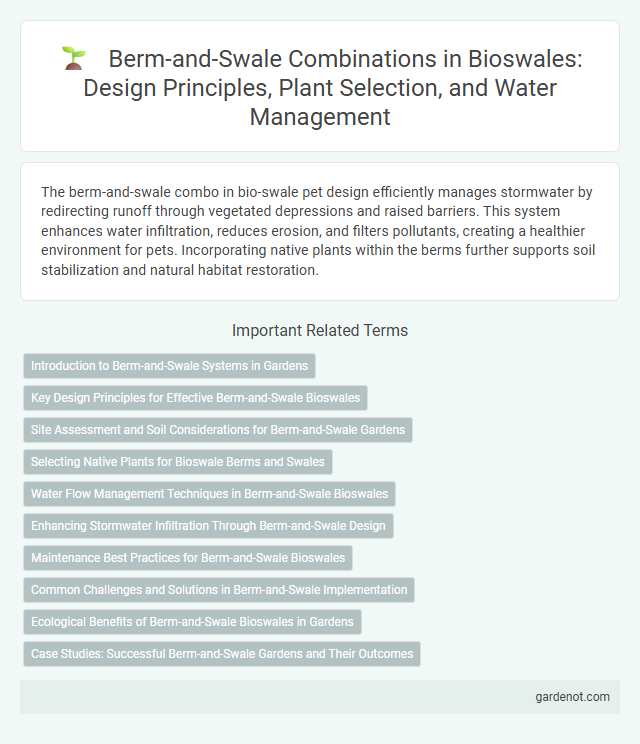The berm-and-swale combo in bio-swale pet design efficiently manages stormwater by redirecting runoff through vegetated depressions and raised barriers. This system enhances water infiltration, reduces erosion, and filters pollutants, creating a healthier environment for pets. Incorporating native plants within the berms further supports soil stabilization and natural habitat restoration.
Introduction to Berm-and-Swale Systems in Gardens
Berm-and-swale systems in gardens are designed to manage stormwater by redirecting runoff and enhancing water infiltration. A berm is a raised barrier that channels water into a swale, a shallow, vegetated depression that slows water flow and promotes soil absorption. This combination optimizes natural irrigation, reduces erosion, and supports garden health with sustainable water management.
Key Design Principles for Effective Berm-and-Swale Bioswales
Key design principles for effective berm-and-swale bioswales include maximizing water infiltration and sediment capture by strategically positioning the berm to slow runoff. Optimizing the gradient and shape of the swale enhances flow distribution and prevents erosion while supporting native vegetation for pollutant filtration. Incorporating appropriate soil media and maintaining adequate depth ensures sustained water retention and treatment capacity in the bioswale system.
Site Assessment and Soil Considerations for Berm-and-Swale Gardens
Site assessment for berm-and-swale gardens requires evaluating soil texture, permeability, and organic matter content to ensure proper water infiltration and retention. Soil with moderate to high infiltration rates and low compaction supports effective stormwater management within the berm-and-swale system. Incorporating native soil amendments and optimizing grading enhances plant health and maximizes pollutant filtration in bio-swales.
Selecting Native Plants for Bioswale Berms and Swales
Choosing native plants for bioswale berms and swales enhances stormwater management by improving soil infiltration and reducing erosion. Deep-rooted grasses and flowering perennials adapted to local climate conditions increase the biofiltration efficiency and provide habitat for pollinators. Native species such as switchgrass, blueflag iris, and joe-pye weed offer resilience in fluctuating moisture levels typical of bioswale environments.
Water Flow Management Techniques in Berm-and-Swale Bioswales
Berm-and-swale bioswales utilize contoured earth mounds and shallow channels to efficiently direct stormwater, enhancing infiltration and reducing runoff velocity. The berm acts as a natural barrier that slows water flow, allowing sediment and pollutants to settle, while the swale promotes groundwater recharge through vegetated depressions. This combination optimizes water flow management by balancing surface detention and subsurface absorption, crucial for sustainable urban drainage systems.
Enhancing Stormwater Infiltration Through Berm-and-Swale Design
Berm-and-swale systems significantly improve stormwater infiltration by directing runoff into vegetated swales where water slows, spreads, and percolates into the soil. The berm acts as an elevated barrier that controls flow velocity and maximizes retention time, promoting groundwater recharge and reducing surface runoff. Integrating native plants in the swale enhances filtration, sediment capture, and pollutant removal, supporting sustainable urban drainage and flood mitigation efforts.
Maintenance Best Practices for Berm-and-Swale Bioswales
Effective maintenance of berm-and-swale bioswales involves regular inspection to ensure proper water flow and prevent sediment buildup that can compromise functionality. Vegetation management is critical, including routine trimming and removal of invasive species to maintain plant health and maximize pollutant filtration. Seasonal debris clearance and erosion control practices preserve structural integrity and optimize stormwater absorption and infiltration.
Common Challenges and Solutions in Berm-and-Swale Implementation
Common challenges in berm-and-swale implementation include soil erosion, improper grading, and inadequate vegetation establishment, which can compromise water retention and filtration effectiveness. Solutions involve using erosion control blankets, precise slope design for optimal drainage, and selecting native plants with deep root systems to stabilize soil and enhance pollutant removal. Regular maintenance such as sediment removal and vegetation management ensures long-term functionality of the bio-swale system.
Ecological Benefits of Berm-and-Swale Bioswales in Gardens
Berm-and-swale bioswales in gardens enhance water infiltration and reduce stormwater runoff by mimicking natural hydrological patterns, promoting groundwater recharge. These systems support biodiversity by providing habitat for native plants, insects, and pollinators, while improving soil health through increased organic matter and microbial activity. The combination of berms and swales also filters pollutants and sediments, thus improving water quality in surrounding ecosystems.
Case Studies: Successful Berm-and-Swale Gardens and Their Outcomes
Case studies of berm-and-swale gardens demonstrate significant improvements in stormwater management, reducing runoff by up to 60% and enhancing groundwater recharge. Projects such as the Portland EcoDistrict and Toronto's Urban Rain Garden showcase increased vegetation health and biodiversity, alongside measurable decreases in soil erosion. These successful implementations highlight the berm-and-swale combo as an effective sustainable landscaping technique for urban water conservation and flood mitigation.
Berm-and-swale combo Infographic

 gardenot.com
gardenot.com